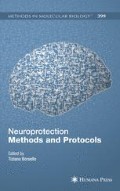Abstract
The promoter regions of many detoxification enzymes contain a cis-acting enhancer known as the antioxidant response element (ARE). NF-E2-related factor 2 (Nrf2) is considered as one of the major transcription factors for the ARE. Nrf2-dependent transcriptional activation by means of the ARE is known to coordinate the upregulation of these antioxidant enzymes involved in combating oxidative stress and has been shown to be protective against neural toxicants. The mitochondrial complex II inhibitor malonate causes striatal damage reminiscent of Huntington’s disease and is known to involve oxidative stress in its pathogenesis. In order to achieve a systemic upregulation of antioxidant potential in local striatal region, a cell-based, Nrf2-dependent antioxidant gene therapy is performed to attenuate malonate-induced neuronal cell death. The details for generating Nrf2-overexpressing astrocytes and grafting them onto the lesion model are described in this chapter.
Access this chapter
Tax calculation will be finalised at checkout
Purchases are for personal use only
References
Rushmore, T. H., Morton, M. R., and Pickett, C. B. (1991) The antioxidant responsive element. Activation by oxidative stress and identification of the DNA consensus sequence required for functional activity. J Biol Chem 266, 11632–11639.
Wasserman, W. W. and Fahl, W. E. (1997) Functional antioxidant responsive elements. Proc Natl Acad Sci USA 94, 5361–5366.
Motohashi, H., O’Connor, T., Katsuoka, F., Engel, J. D., and Yamamoto, M. (2002) Integration and diversity of the regulatory network composed of Maf and CNC families of transcription factors. Gene 294, 1–12.
Li, J., Stein, T. D., and Johnson, J. A. (2004) Genetic dissection of systemic autoimmune disease in Nrf2-deficient mice. Physiol Genomics 18, 261–272.
Lee, J. M., Calkins, M. J., Chan, K., Kan, Y. W., and Johnson, J. A. (2003) Identification of the NF-E2-related factor-2-dependent genes conferring protection against oxidative stress in primary cortical astrocytes using oligonucleotide microarray analysis. J Biol Chem 278, 12029–12038.
Shih, A. Y., Johnson, D. A., Wong, G., Kraft, A. D., Jiang, L., Erb, H., Johnson, J. A., and Murphy, T. H. (2003) Coordinate regulation of glutathione biosynthesis and release by Nrf2-expressing glia potently protects neurons from oxidative stress. J Neurosci 23, 3394–3406.
Kraft, A. D., Johnson, D. A., and Johnson, J. A. (2004) Nuclear factor E2-related factor 2-dependent antioxidant response element activation by tertbutylhydroquinone and sulforaphane occurring preferentially in astrocytes conditions neurons against oxidative insult. J Neurosci 24, 1101–1112.
Calkins, M. J., Jakel, R. J., Johnson, D. A., Chan, K., Kan, Y. W., and Johnson, J. A. (2005) Protection from mitochondrial complex II inhibition in vitro and in vivo by Nrf2-mediated transcription. Proc Natl Acad Sci USA 102, 244–249.
Johnson, D. A., Andrews, G. K., Xu, W., and Johnson, J. A. (2002) Activation of the antioxidant response element in primary cortical neuronal cultures derived from transgenic reporter mice. J Neurochem 81, 1233–1241.
Alam, J., Stewart, D., Touchard, C., Boinapally, S., Choi, A. M., and Cook, J. L. (1999) Nrf2, a Cap‘n’Collar transcription factor, regulates induction of the heme oxygenase-1 gene. J Biol Chem 274, 26071–26078.
Hardy, S., Kitamura, M., Harris-Stansil, T., Dai, Y., and Phipps, M. L. (1997) Construction of adenovirus vectors through Cre-lox recombination. J Virol 71, 1842–1849.
Paxinos, G. and Franklin, K. B. J. (2001) The Mouse Brain in Stereotaxic Coordinates, 2nd edn. Academic Press, San Diego, CA.
Wu, Y. Y., Mujtaba, T., and Rao, M. S. (2002) Isolation of stem and precursor cells from fetal tissue, in Methods in Molecular Biology, Vol 198: Neural Stem Cells: Methods and Protocols (Zigova, T., Sanberg, P. R., and Sanchez-Ramos, J. R., eds.), Humana Press, Totowa, NJ, pp. 29–40.
Author information
Authors and Affiliations
Editor information
Rights and permissions
Copyright information
© 2007 Humana Press Inc.
About this protocol
Cite this protocol
Li, J., Calkins, M.J., Johnson, D.A., Johnson, J.A. (2007). Role of Nrf2-Dependent ARE-Driven Antioxidant Pathway in Neuroprotection. In: Borsello, T. (eds) Neuroprotection Methods and Protocols. Methods in Molecular Biology, vol 399. Humana Press. https://doi.org/10.1007/978-1-59745-504-6_6
Download citation
DOI: https://doi.org/10.1007/978-1-59745-504-6_6
Publisher Name: Humana Press
Print ISBN: 978-1-58829-666-5
Online ISBN: 978-1-59745-504-6
eBook Packages: Springer Protocols

